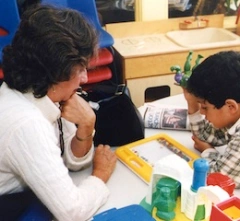 Professional development of teachers, especially in relation to integrating learning technology into the curriculum, is problematic. This scenario is intended to initiate discussion of some key issues and principles involved – what can go wrong? How do we ensure that professional development is effective?
Professional development of teachers, especially in relation to integrating learning technology into the curriculum, is problematic. This scenario is intended to initiate discussion of some key issues and principles involved – what can go wrong? How do we ensure that professional development is effective?
Q: Mary, tell us about your school’s learning technology project…
Mary: Well, we’re meant to be using blogs in the classroom as part of our learning units. So if we’re doing a unit on families and communities, say, there’s a blog where what we find out is recorded on the blog with words and pictures, maybe even some videos of interviews. I guess the purpose is to make sure students develop some skills in using the technology…
Q: You say you are ‘meant to be using blogs’ – how is it working for you?
Mary: To be honest, I haven’t got started with it. I know some of the other teachers are probably doing great things – they’re very confident with using the technology but I’m a bit out of my depth. Sometimes I think the kids know a lot more than I do – scary! And I’m not sure how I’d manage the whole process, whether I’d need to upload everything into the blog or just let the kids do it.
Q: What professional development have you had?
Mary: We had a training session at the end of last year. Someone came in and did a demo of what you can do with a blog – I think it was a high school they had worked with, amazing stuff. They were obviously a real expert but some of it went over my head a bit, and I couldn’t really see how it would work in my classroom.
Since then I haven’t had a chance to get started with using blogs – the start of the year is very busy and stressful. But now the term is underway I’ll give it a go – maybe this weekend if I can remember what she showed us. It’s just a matter of sitting down and putting in some serious time – maybe I could check out the public library to see if they have any books on blogging. It’s all a bit daunting but I need to get started before my performance review at the end of term!
Professional development for teaching with technology
Photo: U.S. Census Bureau


 Is connectivism a theory? I guess. But when considering its usefulness to my own teaching and learning, I have reservations.
Is connectivism a theory? I guess. But when considering its usefulness to my own teaching and learning, I have reservations.
 To my surprise, I’m still recommending PBWorks to teachers as a good way to get started using a wiki. That’s because the Moodle wiki is still not a very effective tool, and PBWorks is easy-to-use and provides some good features for developing and formatting content. It’s proprietary, of course, so it has to be
To my surprise, I’m still recommending PBWorks to teachers as a good way to get started using a wiki. That’s because the Moodle wiki is still not a very effective tool, and PBWorks is easy-to-use and provides some good features for developing and formatting content. It’s proprietary, of course, so it has to be  I worked with the management and teaching staff of a small provider to plan strategies for developing the organisation’s capability to incorporate a blended / flexible learning approach into its training and education. One key component was a short professional development programme for teaching staff, with the purpose of developing staff skills in using Moodle and incorporating its use into teaching and learning activities.
I worked with the management and teaching staff of a small provider to plan strategies for developing the organisation’s capability to incorporate a blended / flexible learning approach into its training and education. One key component was a short professional development programme for teaching staff, with the purpose of developing staff skills in using Moodle and incorporating its use into teaching and learning activities. Jan is a nursing lecturer in a department which has recently begun to incorporate a ‘community of practice’ approach, including the use of a wiki for students and staff to collaboratively build publicly-accessible knowledge resources. She logs in one Monday morning and sees that a student has added to the page on clinical practice, including information which is contrary to accepted practice and could put patients’ health at risk.
Jan is a nursing lecturer in a department which has recently begun to incorporate a ‘community of practice’ approach, including the use of a wiki for students and staff to collaboratively build publicly-accessible knowledge resources. She logs in one Monday morning and sees that a student has added to the page on clinical practice, including information which is contrary to accepted practice and could put patients’ health at risk. As a Mac user, I’d never had much fun with SL, but when I saw that
As a Mac user, I’d never had much fun with SL, but when I saw that